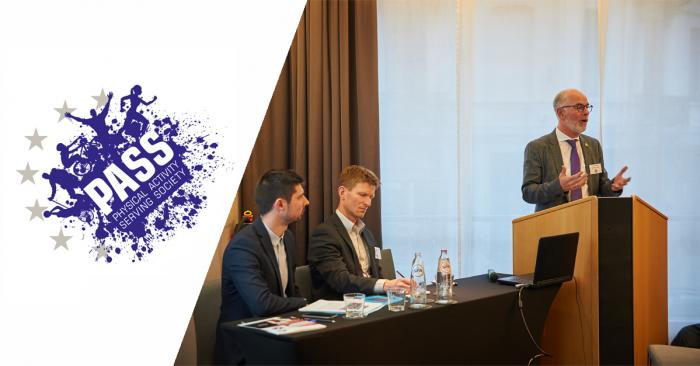What 3 years researching the inactivity crisis have
taught us
Sport and Citizenship embarked on a 36-month European project entitled Physical activity Serving Society (PASS). With the support of six other European stakeholders, EUPEA, FESI, ISCA, ICSSPE, Spolint Institute and TAFISA; PASS undertook a timely campaign that investigated the present status quo of physical activity policies and practices across Europe- at a time when physical inactivity and sedentarism enjoy consistent growth. As the project is wrapping up, the time to share the recommendations is upon us.

The penny has to drop
In the wake of the PASS project, we feel the insight we have gained should be brought to everybody’s attention. Europeans have embarked upon a dangerous path and must change direction. Sedentary lifestyle is simply against our human nature. We have reached critical levels that are ruining our health and wellbeing, those of future generations, our academic and professional productivity, and is weighing down our economies. 210 million Europeans are physically inactive, consequently costing the EU28 80 billion Euros in healthcare every year – a figure that is all the more disturbing since it only accounts for the four largest non-communicable diseases, directly correlated to physical inactivity (coronary heart disease, type 11 diabetes, colorectal and breast cancers). Every year, a million deaths result from inactivity in Europe. Another staggering figure is that 66% of local decision-makers are entirely unaware of this status quo. These are some of the key figures that stand out from our work.
While distressing, hope remains- physical activity and sport are seeking full political recognition. Until they become a priority on the agenda, and until the vast resources available to counter inactivity have been applied efficiently, we cannot resign ourselves to waiving the white flag.
Nobody can fix this alone
Top-down initiatives alone struggle to see practical implementations. The good intentions of the European HEPA (health enhancing physical activity) policy have proved insufficient alone to shape concrete actions, notably due to a shortage of national collaboration and a lack of clear objectives. To ensure the population has easy access to daily physical activity, attention must be given to three requirements.
Partnership approaches enable for greater outcomes. Concerned public life stakeholders include more than policymakers, by the likes of academia, sporting organisations, local authorities, health and education actors, and the general public. The different levels of governance must also collaborate, from local to European levels.
The PASS project also sheds light on the importance the first decade of a child’s life has in shaping healthy and active behaviours. Therefore local youth and grassroots sport possess the broadest scope to equip children with an incline towards regular physical activity and sports, and hence ensure a better health to future generations.
As the home to 75% of the European population, cities are in dire need of long-term investments to facilitate human movement. City policies have an immediate and direct impact on their residents, more so than higher levels of government. Urban planning, effective public transport, and health campaigns are examples of the vast amount of existing solutions- their potential must be harnessed.
Targets to reach
Aside the evidence, numbers, facts and focus points listed above, the legacy of the PASS project consists in the implementation of the following innovations:
- Cross-sector collaboration is essential to attain a coordinated approach to delivering physical activity opportunities. The foundation of such work is to define where individuals spend the most time, for which health, education and urban planning actors are key stakeholders.
- Recognising the importance of the school context: education is sitting on a paradox favouring sitting down. Movement has to be re-introduced before, during and after class, which will consequently improve pupils’ academic performances and health.
- Developing knowledge and awareness around the holistic benefits of physical activity: the gap between research and policymaking must be closed if greater evidence-based policies are to see the day. Improved data collection and monitoring will allow such policies to be created, and further enhance the preventative use of physical activity.
- Attracting citizens through grassroots sports: while national bodies have given little consideration to HEPA, international bodies have embraced it over sport. Providing a broad range of quality, fun activities provides citizens with the possibility to choose what they enjoy best.
- Adapting the cityscape: as stated earlier, cities should seek to become “active cities” by designing movement-friendly spaces and further creating roadmaps to ensure all inhabitants, regardless of age, background and ability, are included.
- Communication and public awareness: Although physical activity promotion cannot rely on media campaigns, the medium permits to inform the population on the risks of sedentarism and benefits of regular movement, in the quest to change public perception.
Cross-sector collaboration and multi-level governance are key
The listed focus points turn the spotlight onto the importance of cross-sector collaboration and multi-level governance. The latter highlights the need to coordinate various levels of authorities, increase the number of actors by including policymakers from all sectors, which will then in turn increase the involved agendas and institutions. By sharing the burden, policies should be more effective and sustainable. The former brings into focus the necessity for stakeholders from different areas of expertise to pull their efforts together in order to deliver solutions to the social issue of sedentarism.
If we unleash the potential of cross-sector collaboration and multi-level governance, together, as a holistic and thorough approach, we genuinely believe the inactivity tide can be breached. With widespread acknowledgement of the issue, it can even be reversed.
Read project PASS’ final recommendations
[1] https://www.sportetcitoyennete.com/wp-content/uploads/2017/02/Narrative-Review_100p.pdf










 MEMBERSHIP
MEMBERSHIP CONTACT
CONTACT FACEBOOK
FACEBOOK